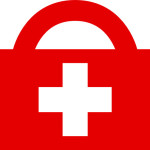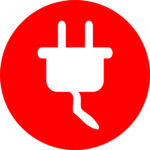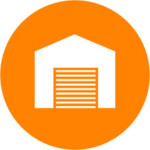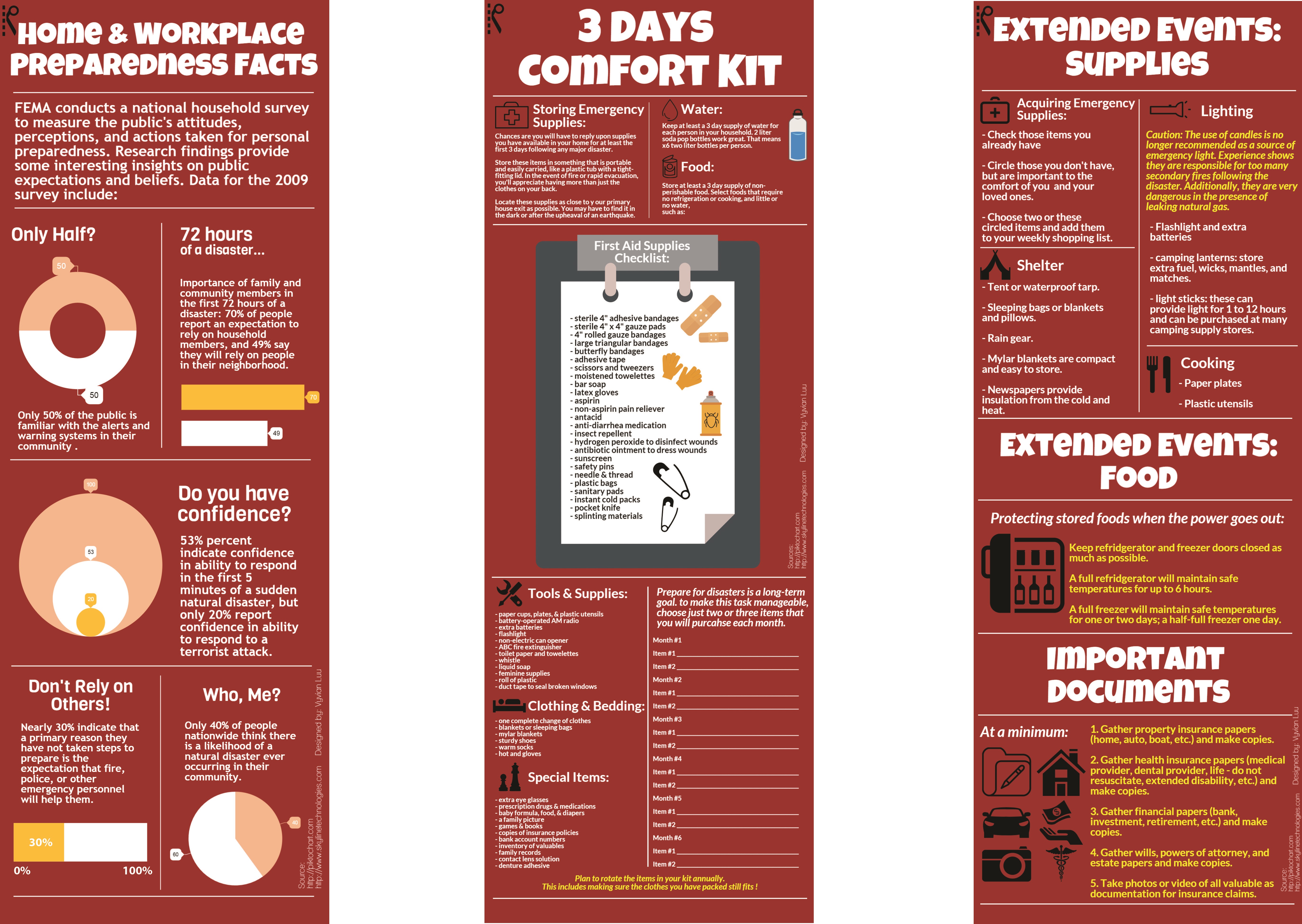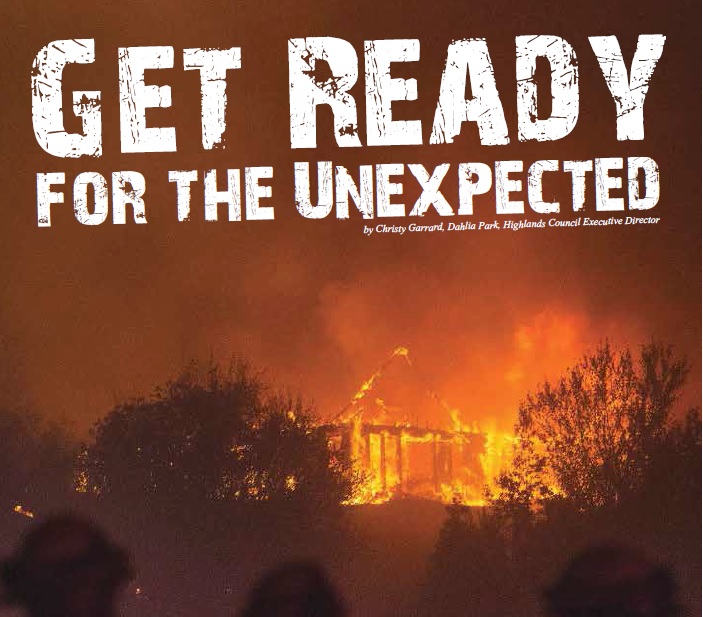
by Christy Garrard, Dahlia Park, Highlands Council Executive Director
Disasters in the Pacific Northwest are most often unexpected. When the worst happens and lives, the environment, and overall public health is at risk our emergency service agencies will be initially overwhelmed by the demand. This issue of Connections introduces basic self-preparedness processes that put you in recovery mode versus survival mode after a catastrophic event.
The resources in this issue are pulled from the Federal and State of Washington Emergency Management Departments, the City of Issaquah CERT Training materials, and the Red Cross. While not comprehensive our intention is to start the conversation in YOUR home with YOUR family about getting prepared. We will follow up monthly with a new column that supports next steps in preparing for disasters and other types of emergencies. So let’s get started.
- Conduct a family meeting and decide how responsibilities will be divided and how you will work together as a team before, during and after an emergency situation.
- Discuss the types of disasters and emergencies that are most likely to occur and explain, especially to children, what to do in each situation.
- Plan an evacuation route from inside your home to outside – where will you meet up outside?
- If we are evacuated from the community where will you go? What would you do with your pets?
- If you are separated during a disaster and cannot return home, designate a second location and make sure everyone knows the address and phone number.
- Designate an “out of area” friend or relative to be THE CONTACT, in case you are separated when disaster strikes and can’t reach each other locally.
- Put together a 3-day emergency supply kit.
- If you have physical or medical needs ensure you have ample supply of medications and supplies if you have to evacuate. Discuss with your medical provider.
Have an evacuation plan.
- Know where you are going and the possible routes to get there.
- Put together a 3-day emergency supply kit (SEE PAGE XX). Store in easy to carry packs.
- Store copies of your vital records in a safety deposit box, including insurance policies.
- Family members should have an out of the area contact they can call to let them know they are safe when the family is separated.
- If you have physical or medical needs be sure to have ample supply of medications. Discuss emergency plans with your medical provider.
When a Wildfire Threatens
- Set up a ladder, garden hoses, and sprinklers on the roof.
- Put on protective clothing to protect body, face, and lungs.
- Remain calm. Listen to radio and television information. Follow advice given by authorities.
- Contact your family and friends and let them know your situation and plans.
- Pre-load your vehicle with emergency supplies, vital records and other valuables.
- Face your vehicle in the direction of escape.
- Keep pets confined nearby.
- Prepare a note to post at your home that tells when you left and where you are going.
When Advised to Evacuate, Do So IMMEDIATELY
- IF there is time – close all windows, vents, doors and remove lightweight curtains. Shut off gas utilities
- Turn ON your home’s lights
- Post your preparedness note on the main entrance
- Lock your doors
- Choose a route away from fire hazards. Drive with your lights ON and watch for emergency vehicles.
- Do not attempt to re-enter the area until firefighters have declared it safe.
Utility Safety: Gas, Electricity and Water
 Natural Gas
Natural Gas
Following earthquakes, explosions from natural gas leaks are responsible for a significant number of fires.
- Every member of the household should know how to shut off the natural gas.
- Locate the shut-off valve . Make sure this valve will turn. To shut off the gas, turn the valve 90o or ¼ turn, so that it crosses the pipe.
- Attach a crescent wrench, at least 12” long, to the meter or to the wall directly behind the meter. Adjust the wrench to fit your valve before hanging it behind the meter in case it rusts.
- Shutting off the gas after an earthquake
- Shut off the gas immediately ONLY if you smell the characteristic odor of gas, you hear a hissing sound, and/or you notice the meter dials spinning more rapidly than normal.
- Do NOT use matches, lighters, open flame appliances, or operate any electrical switches until you are sure no gas leaks exist. Sparks from electrical switches can ignite the gas.
- If you smell natural gas, immediately get everyone out of and away from the house! Open the windows and doors to provide ventilation. Shut off the gas meter.
Water quickly becomes precious following disasters.
- Every member of the household should know how to shut off the water at the main house valve.
- Cracked lines may pollute the water supply to your house. It is recommended to shut off your water until you hear from authorities that it is safe for drinking
- Gravity may drain your hot water and toilet tanks unless you trap it in your house by shutting off the main house valve (NOT the street valve). Locate the shut-off valve (ILLUSTRATION) for the water line that enters your house. Label this valve with a tag for easy identification!
Every household member should know where and how to shut off the electricity to the home.
- Locate the electricity circuit box
- Always shut off all the individual circuits before shutting off the main circuit breaker
 Under the Bed Items – Be Ready to Respond – Day or Night
Under the Bed Items – Be Ready to Respond – Day or Night
When an earthquake hits, especially at night, it will be difficult to think rationally and as quickly as you would like. Having procedures in place will make it easier to spring into appropriate action effectively and efficiently.
AT A MINIMUM – Every family member should have a sturdy pair of shoes under the bed to protect feet from broken glass!
Glass shard lacerations to feet from windows, picture frames, lamps, and clocks are the most common injury after earthquakes.
Also Recommended
- Work gloves to protect hands from broken glass
- Flashlight
- Hardhat
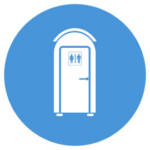 Sanitation – When You Have to GO You Still Gotta Go
Sanitation – When You Have to GO You Still Gotta Go
The lack of sanitation facilities after a major disaster can rapidly create new problems unless basic guidelines are followed.
- If water lines are damaged or suspected of damage Do NOT flush the toilet!
- Avoid digging holes in the ground. Untreated raw sewage pollutes ground water and attracts flies which promotes the spread of disease.
What Can You Do?
- In your supplies make sure you have: a large supply of heavy-duty plastic bags, twist ties, disinfectant, and toilet paper
- A good disinfectant is a solution of one-part liquid bleach to ten-parts water
- You CAN still use the toilet even if it can’t be flushed.
- Remove all the water from the bowl
- Line the bowl with a heavy-duty plastic bag
- When finished, add a small amount of deodorant or disinfectant, securely tie the bag, and dispose of it in a large trash bag with a tight fitting lid (the large trash can should also be lined with a sturdy trash bag).
 Pets and Extended Emergency Events
Pets and Extended Emergency Events
Before a Disaster
- Determine the safest location within your home where you could leave your pet in an emergency (i.e. utility room or bathroom)
- Plan to separate each animal. Stress from a disaster can bring out the worst in even a gentle animal.
- Talk to your veterinarian about medications or special diets if you had to leave your pet alone for several days.
Emergency Supplies for Pets
- Fiberglass carrier for each pet. Tape an envelope to the top of the carrier with a photo of the pet, the pet’s name, vaccination records, medical information, your vet’s name and phone number.
- Food should be dry and relatively unappealing to avoid over eating
- Towels and blankets for warmth
- Baggies for cleanup
- Spray disinfectant and latex gloves
- For cats: litter box and clumping litter and a scoop
During a Disaster
- Keep pets inside.
- If you have to evacuate, LEAVE YOUR PET AT HOME with 3 days supply of water and dry food in containers that are no-spill
- Make sure your pet has on its collar with tags and identification
- Separate dogs from cats. Anxiety can cause animals to act unpredictably
- If you evacuate with your pet remember to bring all medical records and medications
- For health and safety reasons, pets will not be allowed in most public emergency shelters.
The Washington State Emergency Management Department recommends taking a 30-minute walk through your home and consider the securing the following areas in the event the ground was rocking, rolling or shaking violently.
- Check your water heater. Is it securely fastened to wall studs with heavy-metal strapping at the top and bottom? Does the water hater have flexible water and gas connectors?
- Identify tall pieces of furniture that could topple during an earthquake and crush a your child or pet. These include bookcases, hutches, armoires, large TVs. Make plans to strap these pieces to wood studs using straps easily purchased at hardware stores or even on Amazon!
- Take a sentimental journey. Do you have items of sentimental value or other heavy, breakable objects stored high on shelves? Consider moving to a lower location or other security measures.
- Consider other small appliances, computers, and audiovisual equipment that need to be better secured.
- Will heavy hanging plants or hanging light fixtures damage windows if they start swaying?
- Where are and how are your heavily framed pictures, artwork and mirrors secured to walls? Pay special attention to items hung over beds!
- When the ground shakes what kitchen, bedroom and garage cabinet doors will fly open? Consider the contents and how to secure the doors.
- Identify poisons, toxics, or solvents in breakable containers that are located in high or dangerous locations.
Household chemicals are potentially lethal. When the ground moves in an earthquake products you have stored in the garage or under the kitchen sink could spill into a potentially deadly mix! Here are simple steps recommended by the State of Washington Emergency Management Department:
BEFORE A DISASTER SECURE ALL CHEMICALS so they cannot fall, break and mix.
- Identify poisons, toxins, and solvents in breakable containers on open shelves.
- Remove all heavy objects from upper shelves, especially around the car!
- Secure open shelving with nylon webbing (available at hardware and camping supply stores).
- Store paints, gasoline, and other flammable liquids away from natural gas water heaters.
AFTER A DISASTER
- Always assume that spilled chemicals are toxic. These materials can be silent killers if vapors are inhaled or absorbed through the skin or eyes..
- Close off the room where the spill has occurred and mark it. For example, “spilled chemicals inside – use caution.”
- As soon as possible, notify the fire department that you have a chemical spill
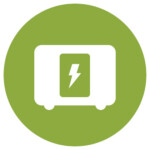 Using a Generator During Power Outages
Using a Generator During Power Outages
Most power outages in the Issaquah Highlands are usually short-lived. Along with mild weather, the need for a generator is rare. But if you do purchase a generator for those occasions, the first step is to make sure you get one listed with the Underwriter’s Laboratory (UL) or Factory Mutual (FM).
Look to the labels on lighting, appliances, and equipment you plan to connect to the generator to determine the amount of power that will be needed to operate the equipment. For lighting, the power of the light bulb indicates the power needed. Appliances and equipment usually have labels indicating power requirements on them. Choose a generator that produces more power than will be drawn by the combination of the items you plan to connect to the generator, plus the initial surge when it is turned on. If your equipment draws more power than the generator can produce, then you may blow a fuse on the generator or damage the connected equipment.
Follow the directions supplied with your generator. Never use portable generators indoors, this includes inside a garage. Adequate ventilation is necessary when running the generator. Proper refueling measures, outlined in the owner’s manual, must be carefully followed. Make sure you have properly working Carbon Monoxide (CO) alarms inside your home.
Allow your generator cool down before refueling. You must store extra generator fuel in an approved safety can. Store fuel for the generator out of doors in a locked shed or other protected area. Do not store fuel in a garage, basement, or anywhere inside a home, vapors can be released that may cause illness and are a potential fire or explosion hazard.
Connect the equipment you want to power directly to the outlets on the generator. Do not hook up a generator to your home’s electrical service. Home-use (nonindustrial) generators do not supply enough amperage to supply sufficient power for today’s homes (that is, to run a furnace; lighting, appliances, and other electronic equipment).
Improper connection methods not only endanger the building occupants, but pose a serious hazard to electric utility workers as well.
For details, refer to technical information from the American Red Cross, and the National Fire Protection Association, Washington Military Department, Emergency Management Division, 2002
This story is formatted for ease of reading, and to clip out the following check lists, in October Connections News.

